Professionalism Ethics and Governance - Case Study Response Template
VerifiedAdded on 2023/06/09
|9
|1707
|413
AI Summary
This is a response template for a case study on professionalism, ethics and governance. It includes analysis of the consequences and actions, ACS Code of Professional Conduct analysis, legislative and international standards analysis, and justifying a decision and recommending appropriate action.
Contribute Materials
Your contribution can guide someone’s learning journey. Share your
documents today.
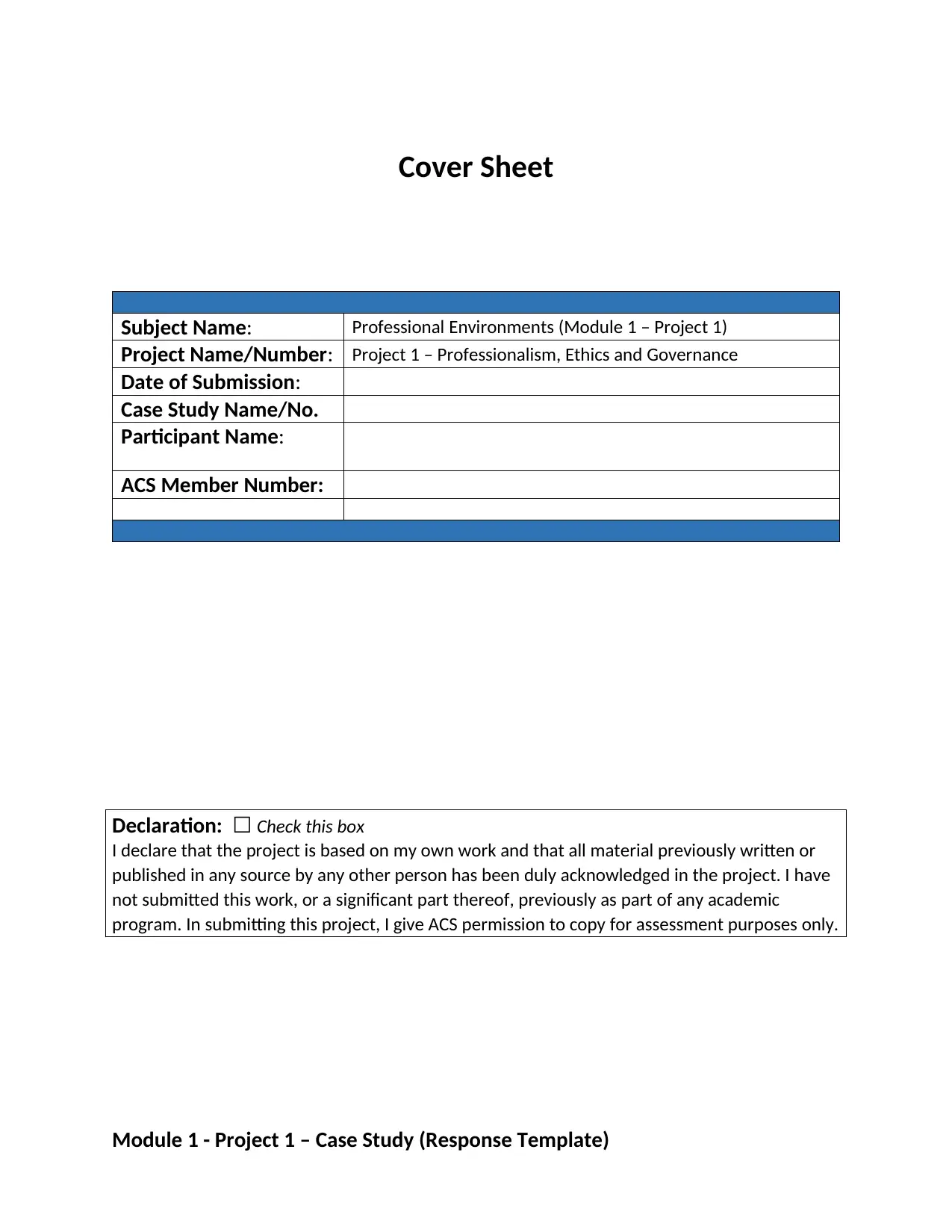
Cover Sheet
Subject Name: Professional Environments (Module 1 – Project 1)
Project Name/Number: Project 1 – Professionalism, Ethics and Governance
Date of Submission:
Case Study Name/No.
Participant Name:
ACS Member Number:
Declaration: ☐ Check this box
I declare that the project is based on my own work and that all material previously written or
published in any source by any other person has been duly acknowledged in the project. I have
not submitted this work, or a significant part thereof, previously as part of any academic
program. In submitting this project, I give ACS permission to copy for assessment purposes only.
Module 1 - Project 1 – Case Study (Response Template)
Subject Name: Professional Environments (Module 1 – Project 1)
Project Name/Number: Project 1 – Professionalism, Ethics and Governance
Date of Submission:
Case Study Name/No.
Participant Name:
ACS Member Number:
Declaration: ☐ Check this box
I declare that the project is based on my own work and that all material previously written or
published in any source by any other person has been duly acknowledged in the project. I have
not submitted this work, or a significant part thereof, previously as part of any academic
program. In submitting this project, I give ACS permission to copy for assessment purposes only.
Module 1 - Project 1 – Case Study (Response Template)
Secure Best Marks with AI Grader
Need help grading? Try our AI Grader for instant feedback on your assignments.
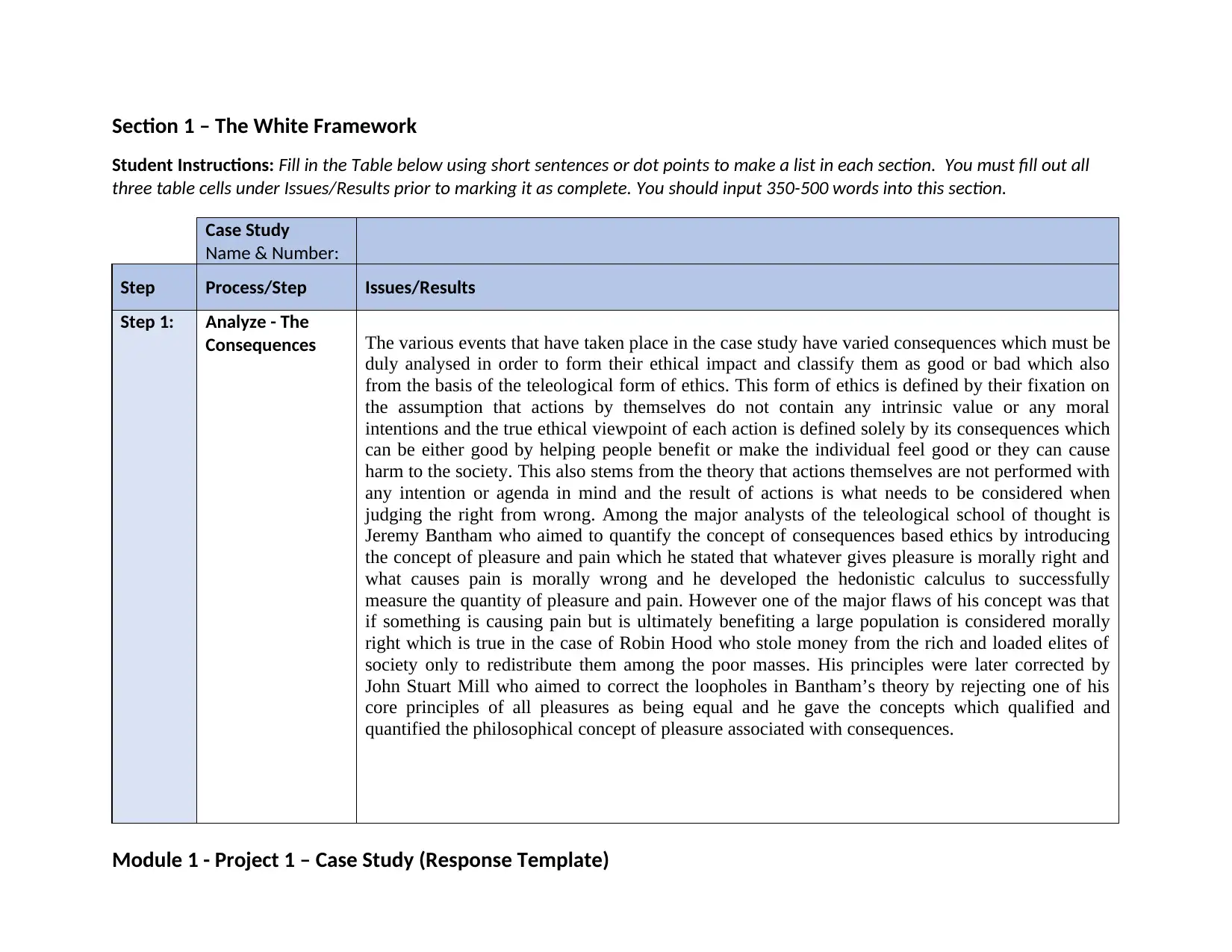
Section 1 – The White Framework
Student Instructions: Fill in the Table below using short sentences or dot points to make a list in each section. You must fill out all
three table cells under Issues/Results prior to marking it as complete. You should input 350-500 words into this section.
Case Study
Name & Number:
Step Process/Step Issues/Results
Step 1: Analyze - The
Consequences The various events that have taken place in the case study have varied consequences which must be
duly analysed in order to form their ethical impact and classify them as good or bad which also
from the basis of the teleological form of ethics. This form of ethics is defined by their fixation on
the assumption that actions by themselves do not contain any intrinsic value or any moral
intentions and the true ethical viewpoint of each action is defined solely by its consequences which
can be either good by helping people benefit or make the individual feel good or they can cause
harm to the society. This also stems from the theory that actions themselves are not performed with
any intention or agenda in mind and the result of actions is what needs to be considered when
judging the right from wrong. Among the major analysts of the teleological school of thought is
Jeremy Bantham who aimed to quantify the concept of consequences based ethics by introducing
the concept of pleasure and pain which he stated that whatever gives pleasure is morally right and
what causes pain is morally wrong and he developed the hedonistic calculus to successfully
measure the quantity of pleasure and pain. However one of the major flaws of his concept was that
if something is causing pain but is ultimately benefiting a large population is considered morally
right which is true in the case of Robin Hood who stole money from the rich and loaded elites of
society only to redistribute them among the poor masses. His principles were later corrected by
John Stuart Mill who aimed to correct the loopholes in Bantham’s theory by rejecting one of his
core principles of all pleasures as being equal and he gave the concepts which qualified and
quantified the philosophical concept of pleasure associated with consequences.
Module 1 - Project 1 – Case Study (Response Template)
Student Instructions: Fill in the Table below using short sentences or dot points to make a list in each section. You must fill out all
three table cells under Issues/Results prior to marking it as complete. You should input 350-500 words into this section.
Case Study
Name & Number:
Step Process/Step Issues/Results
Step 1: Analyze - The
Consequences The various events that have taken place in the case study have varied consequences which must be
duly analysed in order to form their ethical impact and classify them as good or bad which also
from the basis of the teleological form of ethics. This form of ethics is defined by their fixation on
the assumption that actions by themselves do not contain any intrinsic value or any moral
intentions and the true ethical viewpoint of each action is defined solely by its consequences which
can be either good by helping people benefit or make the individual feel good or they can cause
harm to the society. This also stems from the theory that actions themselves are not performed with
any intention or agenda in mind and the result of actions is what needs to be considered when
judging the right from wrong. Among the major analysts of the teleological school of thought is
Jeremy Bantham who aimed to quantify the concept of consequences based ethics by introducing
the concept of pleasure and pain which he stated that whatever gives pleasure is morally right and
what causes pain is morally wrong and he developed the hedonistic calculus to successfully
measure the quantity of pleasure and pain. However one of the major flaws of his concept was that
if something is causing pain but is ultimately benefiting a large population is considered morally
right which is true in the case of Robin Hood who stole money from the rich and loaded elites of
society only to redistribute them among the poor masses. His principles were later corrected by
John Stuart Mill who aimed to correct the loopholes in Bantham’s theory by rejecting one of his
core principles of all pleasures as being equal and he gave the concepts which qualified and
quantified the philosophical concept of pleasure associated with consequences.
Module 1 - Project 1 – Case Study (Response Template)

Step 2: Analyze - The
Actions
On the opposite end of the spectrum as given in the case study, is the field of Deontological ethics
in which it is widely accepted that actions have intrinsic value attached to them and their inherent
nature contains the capacity of good versus evil making their consequences irrelevant when
somebody aims to label and divide the difference between good and bad. For example saying the
truth, being honest and keeping the trust intact of somebody close to you and staying loyal are
considered inherently good actions meanwhile telling lies, backstabbing and plotting against people
and committing crimes by themselves are considered bad actions.
Step 3: Make A Decision
After carefully studying both the branches of these ethics, it is very important to make a decision
based on the fact that both the actions and their potential consequences must not inflict a major
degree of harm upon the people who are either directly or indirectly involved and the original
intention behind committing such actions must not be criminal or largely damaging in nature.
Actions such as helping somebody cannot be considered moral outright as it is also necessary to
analyse where the desire to help is coming from and the origin of the finances being used for
charity.
Module 1 - Project 1 – Case Study (Response Template)
Actions
On the opposite end of the spectrum as given in the case study, is the field of Deontological ethics
in which it is widely accepted that actions have intrinsic value attached to them and their inherent
nature contains the capacity of good versus evil making their consequences irrelevant when
somebody aims to label and divide the difference between good and bad. For example saying the
truth, being honest and keeping the trust intact of somebody close to you and staying loyal are
considered inherently good actions meanwhile telling lies, backstabbing and plotting against people
and committing crimes by themselves are considered bad actions.
Step 3: Make A Decision
After carefully studying both the branches of these ethics, it is very important to make a decision
based on the fact that both the actions and their potential consequences must not inflict a major
degree of harm upon the people who are either directly or indirectly involved and the original
intention behind committing such actions must not be criminal or largely damaging in nature.
Actions such as helping somebody cannot be considered moral outright as it is also necessary to
analyse where the desire to help is coming from and the origin of the finances being used for
charity.
Module 1 - Project 1 – Case Study (Response Template)
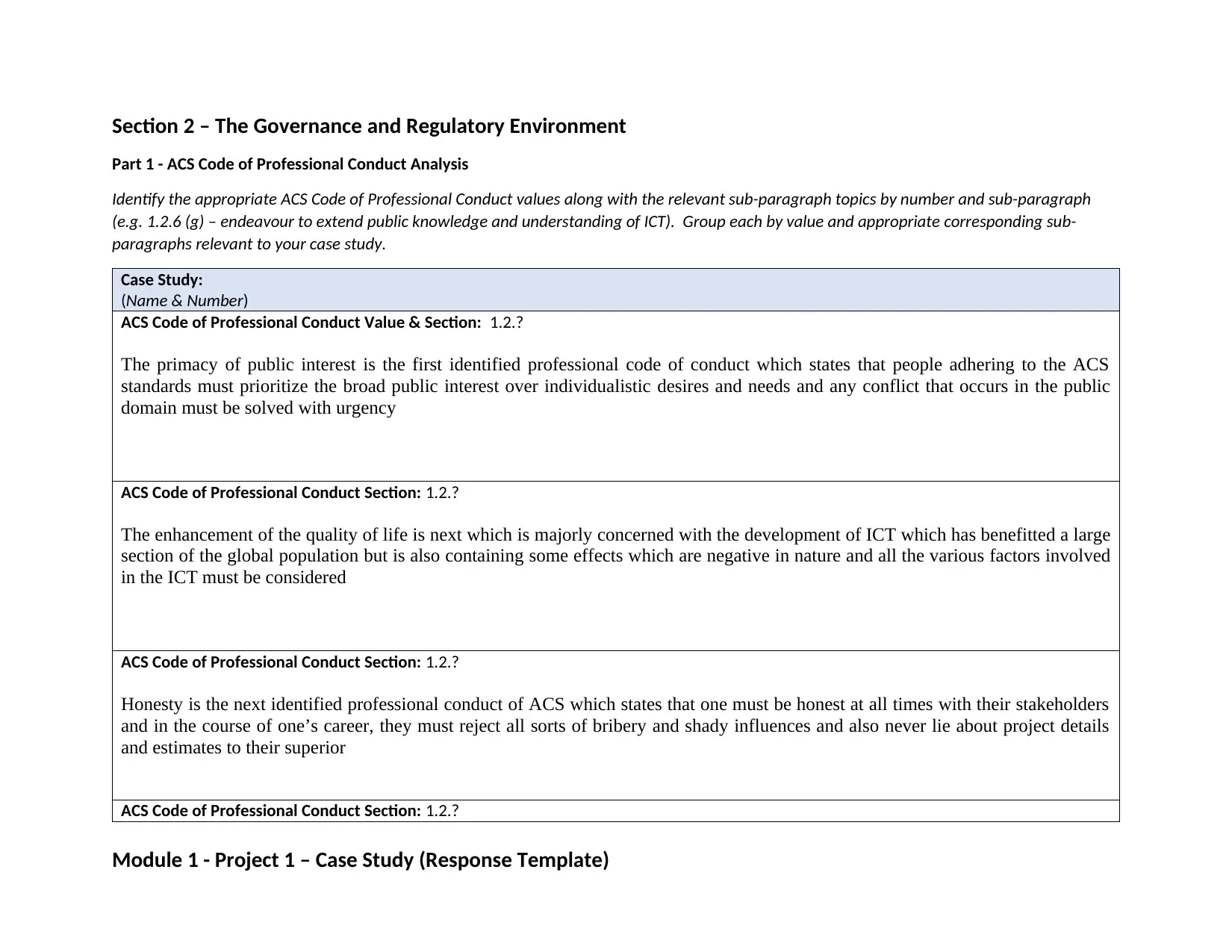
Section 2 – The Governance and Regulatory Environment
Part 1 - ACS Code of Professional Conduct Analysis
Identify the appropriate ACS Code of Professional Conduct values along with the relevant sub-paragraph topics by number and sub-paragraph
(e.g. 1.2.6 (g) – endeavour to extend public knowledge and understanding of ICT). Group each by value and appropriate corresponding sub-
paragraphs relevant to your case study.
Case Study:
(Name & Number)
ACS Code of Professional Conduct Value & Section: 1.2.?
The primacy of public interest is the first identified professional code of conduct which states that people adhering to the ACS
standards must prioritize the broad public interest over individualistic desires and needs and any conflict that occurs in the public
domain must be solved with urgency
ACS Code of Professional Conduct Section: 1.2.?
The enhancement of the quality of life is next which is majorly concerned with the development of ICT which has benefitted a large
section of the global population but is also containing some effects which are negative in nature and all the various factors involved
in the ICT must be considered
ACS Code of Professional Conduct Section: 1.2.?
Honesty is the next identified professional conduct of ACS which states that one must be honest at all times with their stakeholders
and in the course of one’s career, they must reject all sorts of bribery and shady influences and also never lie about project details
and estimates to their superior
ACS Code of Professional Conduct Section: 1.2.?
Module 1 - Project 1 – Case Study (Response Template)
Part 1 - ACS Code of Professional Conduct Analysis
Identify the appropriate ACS Code of Professional Conduct values along with the relevant sub-paragraph topics by number and sub-paragraph
(e.g. 1.2.6 (g) – endeavour to extend public knowledge and understanding of ICT). Group each by value and appropriate corresponding sub-
paragraphs relevant to your case study.
Case Study:
(Name & Number)
ACS Code of Professional Conduct Value & Section: 1.2.?
The primacy of public interest is the first identified professional code of conduct which states that people adhering to the ACS
standards must prioritize the broad public interest over individualistic desires and needs and any conflict that occurs in the public
domain must be solved with urgency
ACS Code of Professional Conduct Section: 1.2.?
The enhancement of the quality of life is next which is majorly concerned with the development of ICT which has benefitted a large
section of the global population but is also containing some effects which are negative in nature and all the various factors involved
in the ICT must be considered
ACS Code of Professional Conduct Section: 1.2.?
Honesty is the next identified professional conduct of ACS which states that one must be honest at all times with their stakeholders
and in the course of one’s career, they must reject all sorts of bribery and shady influences and also never lie about project details
and estimates to their superior
ACS Code of Professional Conduct Section: 1.2.?
Module 1 - Project 1 – Case Study (Response Template)
Secure Best Marks with AI Grader
Need help grading? Try our AI Grader for instant feedback on your assignments.
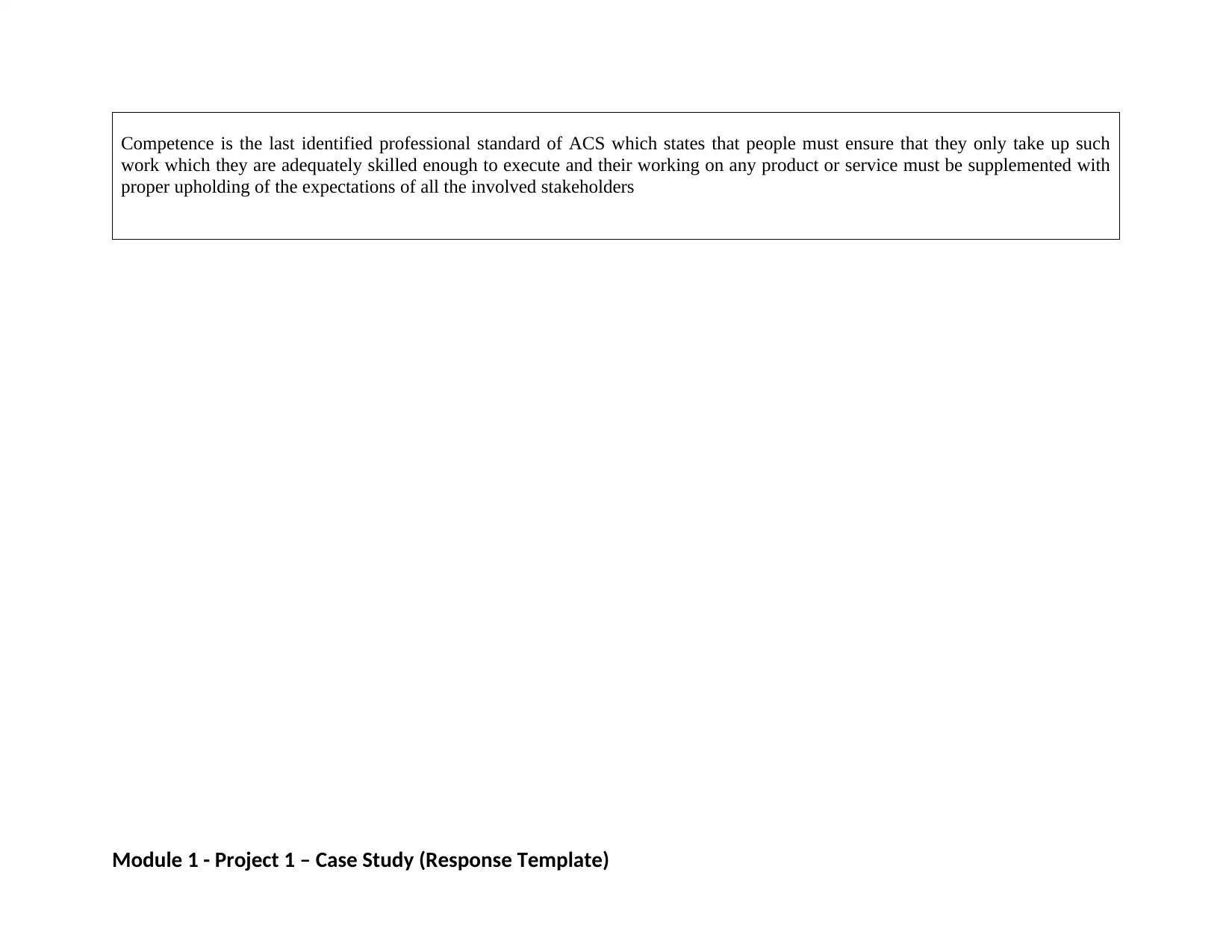
Competence is the last identified professional standard of ACS which states that people must ensure that they only take up such
work which they are adequately skilled enough to execute and their working on any product or service must be supplemented with
proper upholding of the expectations of all the involved stakeholders
Module 1 - Project 1 – Case Study (Response Template)
work which they are adequately skilled enough to execute and their working on any product or service must be supplemented with
proper upholding of the expectations of all the involved stakeholders
Module 1 - Project 1 – Case Study (Response Template)
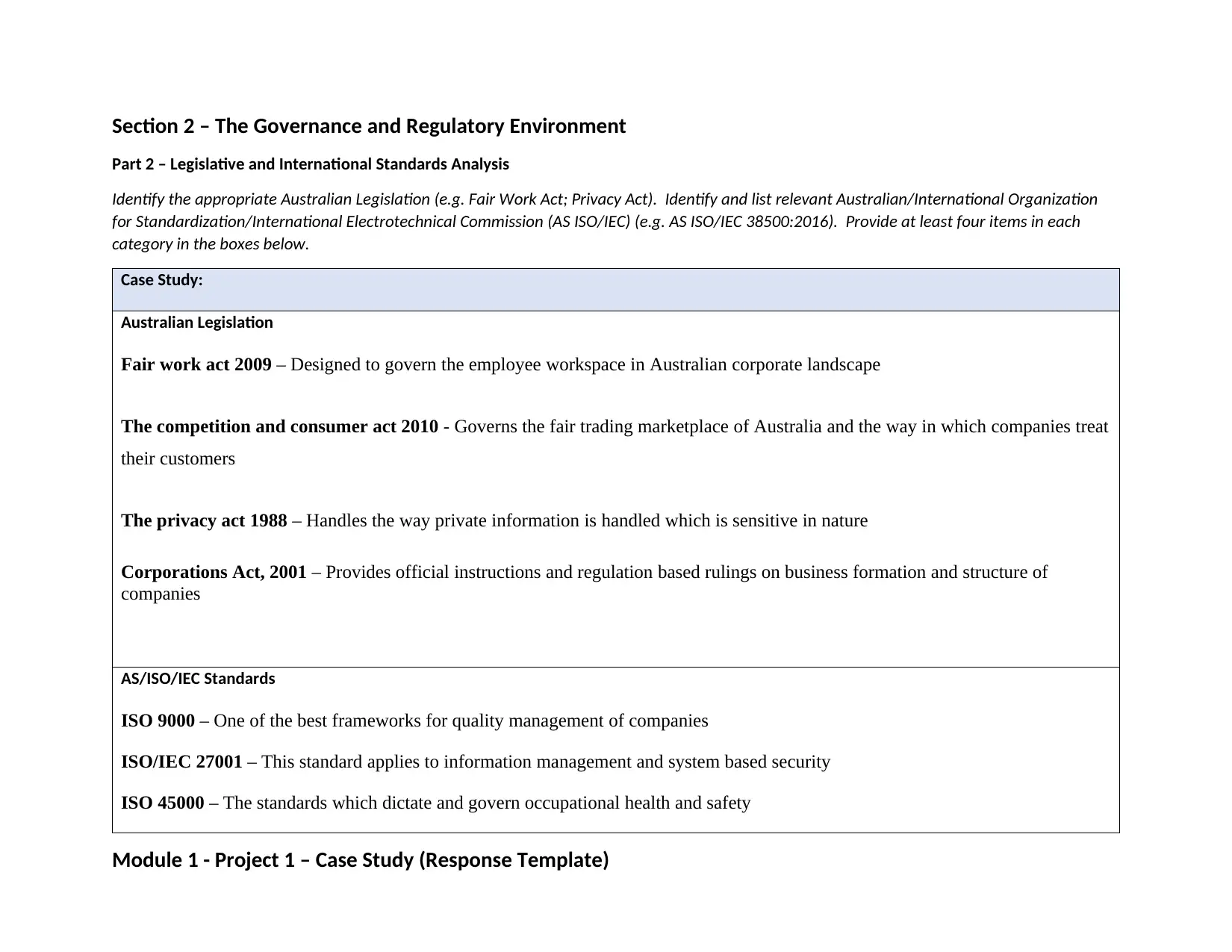
Section 2 – The Governance and Regulatory Environment
Part 2 – Legislative and International Standards Analysis
Identify the appropriate Australian Legislation (e.g. Fair Work Act; Privacy Act). Identify and list relevant Australian/International Organization
for Standardization/International Electrotechnical Commission (AS ISO/IEC) (e.g. AS ISO/IEC 38500:2016). Provide at least four items in each
category in the boxes below.
Case Study:
Australian Legislation
Fair work act 2009 – Designed to govern the employee workspace in Australian corporate landscape
The competition and consumer act 2010 - Governs the fair trading marketplace of Australia and the way in which companies treat
their customers
The privacy act 1988 – Handles the way private information is handled which is sensitive in nature
Corporations Act, 2001 – Provides official instructions and regulation based rulings on business formation and structure of
companies
AS/ISO/IEC Standards
ISO 9000 – One of the best frameworks for quality management of companies
ISO/IEC 27001 – This standard applies to information management and system based security
ISO 45000 – The standards which dictate and govern occupational health and safety
Module 1 - Project 1 – Case Study (Response Template)
Part 2 – Legislative and International Standards Analysis
Identify the appropriate Australian Legislation (e.g. Fair Work Act; Privacy Act). Identify and list relevant Australian/International Organization
for Standardization/International Electrotechnical Commission (AS ISO/IEC) (e.g. AS ISO/IEC 38500:2016). Provide at least four items in each
category in the boxes below.
Case Study:
Australian Legislation
Fair work act 2009 – Designed to govern the employee workspace in Australian corporate landscape
The competition and consumer act 2010 - Governs the fair trading marketplace of Australia and the way in which companies treat
their customers
The privacy act 1988 – Handles the way private information is handled which is sensitive in nature
Corporations Act, 2001 – Provides official instructions and regulation based rulings on business formation and structure of
companies
AS/ISO/IEC Standards
ISO 9000 – One of the best frameworks for quality management of companies
ISO/IEC 27001 – This standard applies to information management and system based security
ISO 45000 – The standards which dictate and govern occupational health and safety
Module 1 - Project 1 – Case Study (Response Template)
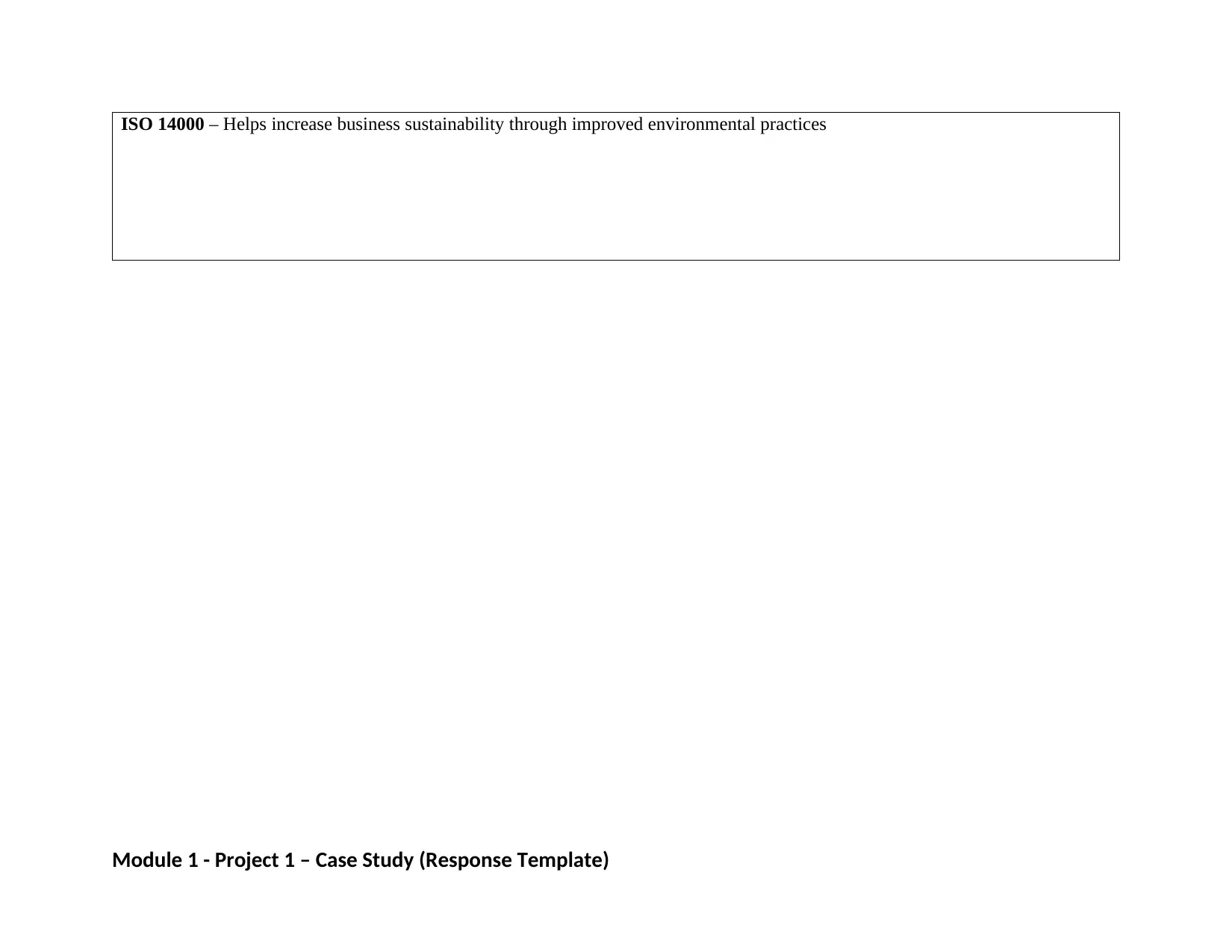
ISO 14000 – Helps increase business sustainability through improved environmental practices
Module 1 - Project 1 – Case Study (Response Template)
Module 1 - Project 1 – Case Study (Response Template)
Paraphrase This Document
Need a fresh take? Get an instant paraphrase of this document with our AI Paraphraser
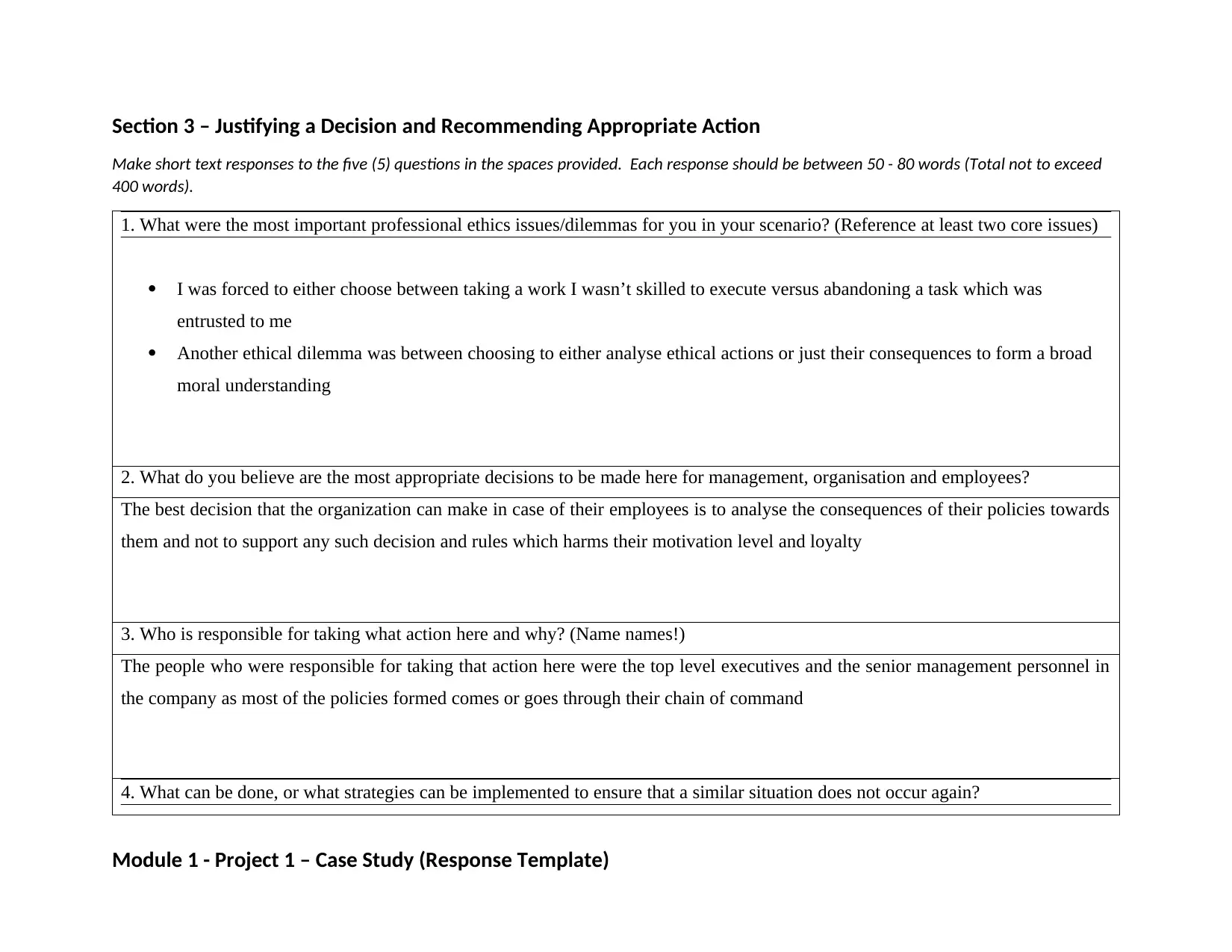
Section 3 – Justifying a Decision and Recommending Appropriate Action
Make short text responses to the five (5) questions in the spaces provided. Each response should be between 50 - 80 words (Total not to exceed
400 words).
1. What were the most important professional ethics issues/dilemmas for you in your scenario? (Reference at least two core issues)
I was forced to either choose between taking a work I wasn’t skilled to execute versus abandoning a task which was
entrusted to me
Another ethical dilemma was between choosing to either analyse ethical actions or just their consequences to form a broad
moral understanding
2. What do you believe are the most appropriate decisions to be made here for management, organisation and employees?
The best decision that the organization can make in case of their employees is to analyse the consequences of their policies towards
them and not to support any such decision and rules which harms their motivation level and loyalty
3. Who is responsible for taking what action here and why? (Name names!)
The people who were responsible for taking that action here were the top level executives and the senior management personnel in
the company as most of the policies formed comes or goes through their chain of command
4. What can be done, or what strategies can be implemented to ensure that a similar situation does not occur again?
Module 1 - Project 1 – Case Study (Response Template)
Make short text responses to the five (5) questions in the spaces provided. Each response should be between 50 - 80 words (Total not to exceed
400 words).
1. What were the most important professional ethics issues/dilemmas for you in your scenario? (Reference at least two core issues)
I was forced to either choose between taking a work I wasn’t skilled to execute versus abandoning a task which was
entrusted to me
Another ethical dilemma was between choosing to either analyse ethical actions or just their consequences to form a broad
moral understanding
2. What do you believe are the most appropriate decisions to be made here for management, organisation and employees?
The best decision that the organization can make in case of their employees is to analyse the consequences of their policies towards
them and not to support any such decision and rules which harms their motivation level and loyalty
3. Who is responsible for taking what action here and why? (Name names!)
The people who were responsible for taking that action here were the top level executives and the senior management personnel in
the company as most of the policies formed comes or goes through their chain of command
4. What can be done, or what strategies can be implemented to ensure that a similar situation does not occur again?
Module 1 - Project 1 – Case Study (Response Template)
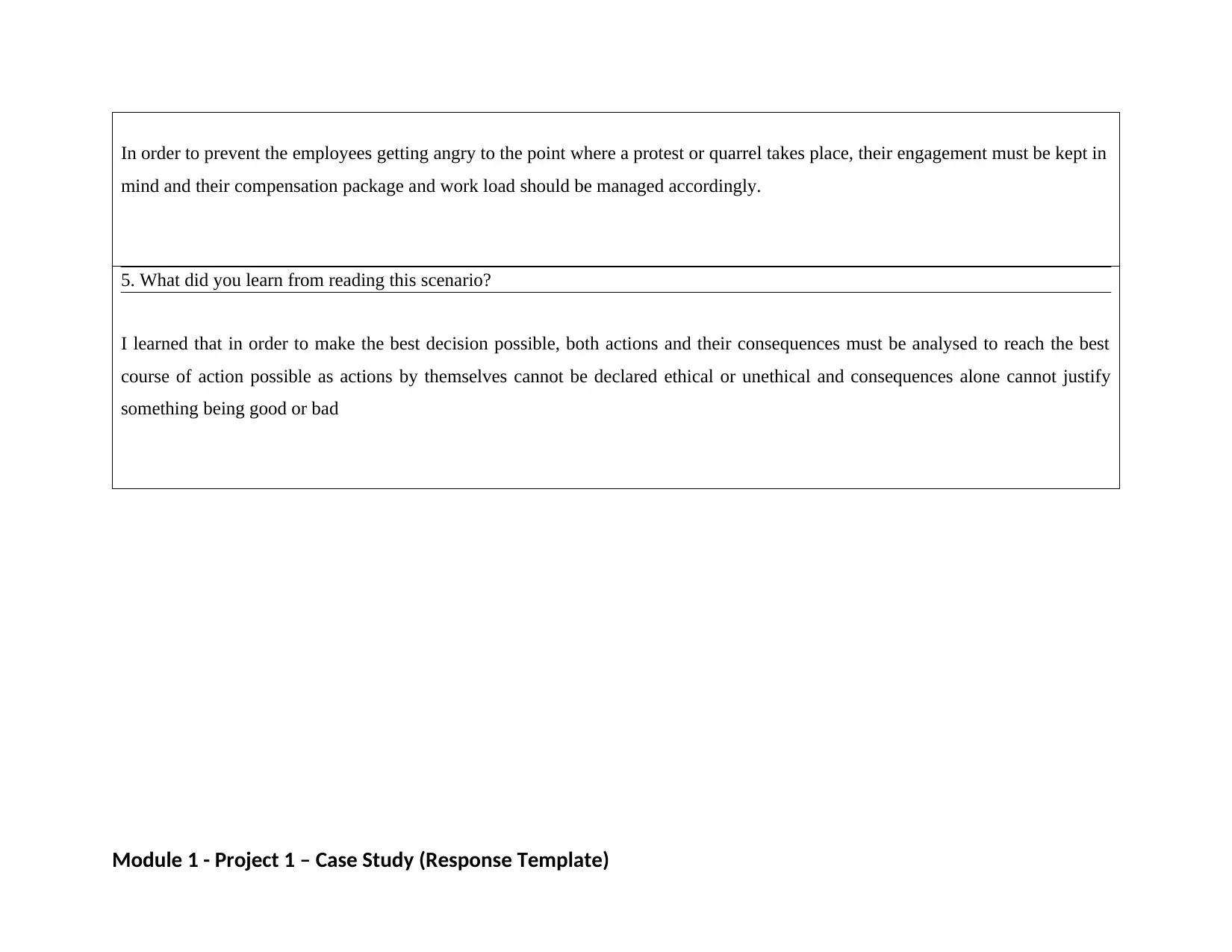
In order to prevent the employees getting angry to the point where a protest or quarrel takes place, their engagement must be kept in
mind and their compensation package and work load should be managed accordingly.
5. What did you learn from reading this scenario?
I learned that in order to make the best decision possible, both actions and their consequences must be analysed to reach the best
course of action possible as actions by themselves cannot be declared ethical or unethical and consequences alone cannot justify
something being good or bad
Module 1 - Project 1 – Case Study (Response Template)
mind and their compensation package and work load should be managed accordingly.
5. What did you learn from reading this scenario?
I learned that in order to make the best decision possible, both actions and their consequences must be analysed to reach the best
course of action possible as actions by themselves cannot be declared ethical or unethical and consequences alone cannot justify
something being good or bad
Module 1 - Project 1 – Case Study (Response Template)
1 out of 9
Related Documents
Your All-in-One AI-Powered Toolkit for Academic Success.
+13062052269
info@desklib.com
Available 24*7 on WhatsApp / Email
![[object Object]](/_next/static/media/star-bottom.7253800d.svg)
Unlock your academic potential
© 2024 | Zucol Services PVT LTD | All rights reserved.





